Blog & Latest Updates
Fly Fishing Articles
Insects by Common Name


Mayfly Species Isonychia bicolor (Mahogany Dun)
Taxonomic Navigation -?-
Kingdom
Animalia (Animals)
» Phylum
Arthropoda (Arthropods)
» Class
Insecta (Insects)
» Order
Ephemeroptera (Mayflies)
» Family
Isonychiidae (Slate Drakes)
» Genus
Isonychia (Slate Drakes)
» Species bicolor (Mahogany Dun)
Common Names
See the main Isonychia page for more about these intriguing mayflies.
Where & When
This species has two distinct emergence peaks, once in late spring or early summer and again in the fall. It may be found on the water in lighter numbers at any time in between.
The first peak begins in the freestone mountain streams of Pennsylvania in early to mid-June. It reaches the Catskills in mid-June and continues through early July. The Upper Midwest and the northern ranges of the Appalachians peak from late June through mid-July.
The second peak usually comes in September, and those flies are more likely to emerge at midday than their Summer brethren.
Isonychia bicolor is only abundant on certain rivers, even in ideal regions. One river can be fantastic while the next drainage over shows no sign of Isonychia.
Hatching Behavior
Time Of Day (?): Usually concentrated in evening with a peak near dusk, especially in Summer; may be sporadic all day
Habitat: Medium to fast water; usually riffles
Water Temperature: Below 70°F
The duns are known for emerging by crawling out onto shore, and one of my streamside pictures shows the nymphal shucks (Habitat: Medium to fast water; usually riffles
Water Temperature: Below 70°F
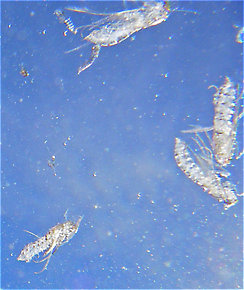
Here's an underwater view of the pupal shucks of several already-emerged Brachycentrus numerosus caddisflies.
When the duns emerge midstream, they're clumsy and make excellent targets for trout. Their heavy bodies ride low in the water, and they often make several failed attempts at flight before succeeding. Low-riding dry flies are good imitations of the placid duns, and heavily hackled patterns may be twitched and skittered to imitate the takeoff commotion.
I've had some of my best dry-fly fishing during sporadic hatches of Isonychia bicolor duns. Trout have an unusually ferocious appetite for them compared to other mayflies of similar size and profile, and they will often smash an imitation when no real duns are on the water.
The duns have pale off-white fore tarsi (
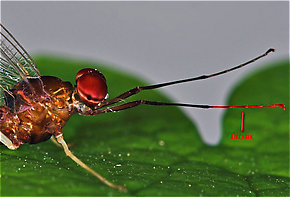
The tarsus of this Isonychia bicolor mayfly spinner is highlighted in red.
Spinner Behavior
See the main Isonychia page for spinner details.
Nymph Biology
Isonychia has some of the most interesting mayfly nymphs; see the main page for the genus for details, which do not really differ between species.
Some books have made a big deal over the strength of the stripe running down the back of Isonychia bicolor nymphs, because it was a confusing identification characteristic used to separate them from Isonychia sadleri. Because the two species are now synonyms (Synonym: A former name of a taxon, usually a species. Entomologists frequently discover that two insects originally described as different species are one in the same, and they drop one of the names. The dropped name is said to be a synonym of the remaining name. These changes take a while to trickle into the common knowledge of anglers; for example, Baetis vagans is now a synonym of Baetis tricaudatus.), the confusion is no longer needed--they're all Isonychia bicolor. However, anglers tying nymph imitations should collect some local specimens before putting bright white stripes down the backs of all their flies. In some populations the stripes are only a little bit lighter than the rest of the body and don't run its whole length. In others, the stripes are indeed vivid enough to warrant the prettier imitation.
Isonychia bicolor Fly Fishing Tips
The size and color of Isonychia bicolor adults may vary throughout the season on a single river, so one should catch specimens from time to time and check them against their imitations.
Pictures of 19 Mayfly Specimens in the Species Isonychia bicolor:
Female Isonychia bicolor (Mahogany Dun) Mayfly Dun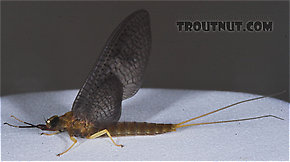 View 13 Pictures
View 13 Pictures
 View 13 Pictures
View 13 PicturesCollected June 14, 2005 from the Namekagon River in Wisconsin
Added to Troutnut.com by Troutnut on May 26, 2006
Added to Troutnut.com by Troutnut on May 26, 2006
Male Isonychia bicolor (Mahogany Dun) Mayfly Spinner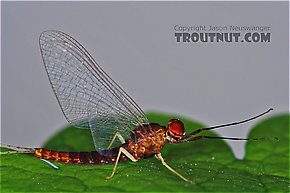 View 15 PicturesI got several really nice pictures of this spinner. I also collected a female on the same trip.
View 15 PicturesI got several really nice pictures of this spinner. I also collected a female on the same trip.
 View 15 PicturesI got several really nice pictures of this spinner. I also collected a female on the same trip.
View 15 PicturesI got several really nice pictures of this spinner. I also collected a female on the same trip.Collected August 9, 2006 from the West Branch of Owego Creek in New York
Added to Troutnut.com by Troutnut on August 11, 2006
Added to Troutnut.com by Troutnut on August 11, 2006
Isonychia bicolor (Mahogany Dun) Mayfly Nymph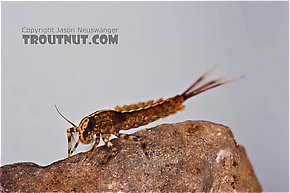 View 7 PicturesThis Isonychia bicolor nymph from the Catskills displays the prominent white stripe sometimes characteristic of its species. This is the first such specimen I've photographed, because members of the same species in the Upper Midwest have a more subdued stripe (and were once thought to be a different species, Isonychia sadleri). The striking coloration on this eastern nymph is more appealing.
View 7 PicturesThis Isonychia bicolor nymph from the Catskills displays the prominent white stripe sometimes characteristic of its species. This is the first such specimen I've photographed, because members of the same species in the Upper Midwest have a more subdued stripe (and were once thought to be a different species, Isonychia sadleri). The striking coloration on this eastern nymph is more appealing.
 View 7 PicturesThis Isonychia bicolor nymph from the Catskills displays the prominent white stripe sometimes characteristic of its species. This is the first such specimen I've photographed, because members of the same species in the Upper Midwest have a more subdued stripe (and were once thought to be a different species, Isonychia sadleri). The striking coloration on this eastern nymph is more appealing.
View 7 PicturesThis Isonychia bicolor nymph from the Catskills displays the prominent white stripe sometimes characteristic of its species. This is the first such specimen I've photographed, because members of the same species in the Upper Midwest have a more subdued stripe (and were once thought to be a different species, Isonychia sadleri). The striking coloration on this eastern nymph is more appealing.Collected April 19, 2006 from the Beaverkill River in New York
Added to Troutnut.com by Troutnut on April 21, 2006
Added to Troutnut.com by Troutnut on April 21, 2006
Isonychia nymph swimming around
Starring: Isonychia bicolor Mayfly Nymph
These nymphs may be the best swimmers of all North American mayflies.
LocationNamekagon River
Date ShotJan 19, 2004
Date AddedMar 31, 2006
AuthorTroutnut
CameraOlympus C740UZ
Recent Discussions of Isonychia bicolor
Your Thoughts On Isonychia bicolor:
Top 10 Fly Hatches
Top Gift Shop Designs
Eat mayflies.
Top Insect Specimens
Miscellaneous Sites
Troutnut.com is copyright © 2004-2024 Jason
Neuswanger (email Jason). See my FAQ for information about use of my images.
 privacy policy
privacy policy
